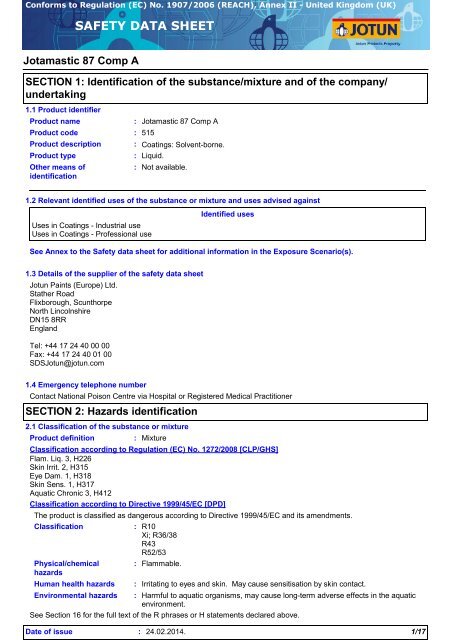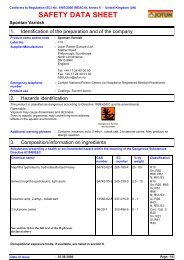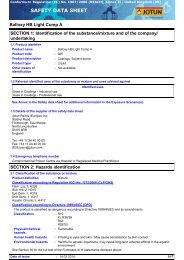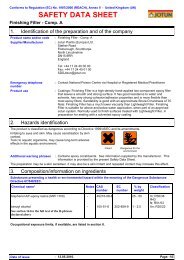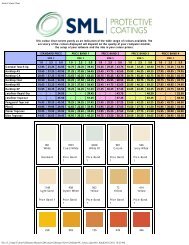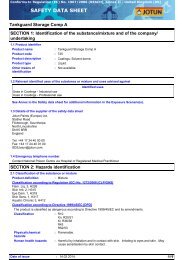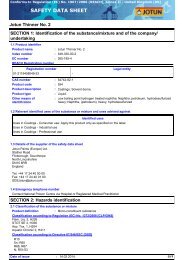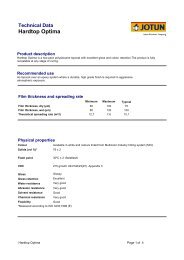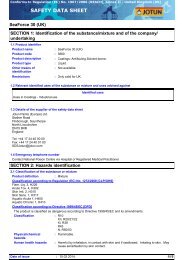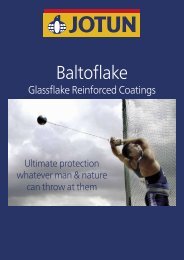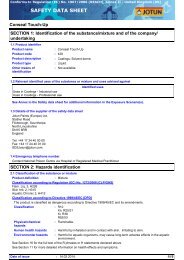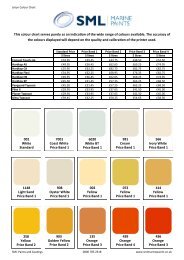Safety data sheet for Jotamastic 87 - Comp. A - SML Marine Paints
Safety data sheet for Jotamastic 87 - Comp. A - SML Marine Paints
Safety data sheet for Jotamastic 87 - Comp. A - SML Marine Paints
- No tags were found...
Create successful ePaper yourself
Turn your PDF publications into a flip-book with our unique Google optimized e-Paper software.
Con<strong>for</strong>ms to Regulation (EC) No. 1907/2006 (REACH), Annex II - United Kingdom (UK)SAFETY DATA SHEET<strong>Jotamastic</strong> <strong>87</strong> <strong>Comp</strong> ASECTION 1: Identification of the substance/mixture and of the company/undertaking1.1 Product identifierProduct name :Product code :Product description :Product type :Other means ofidentification:<strong>Jotamastic</strong> <strong>87</strong> <strong>Comp</strong> A515Coatings: Solvent-borne.Liquid.Not available.1.2 Relevant identified uses of the substance or mixture and uses advised againstUses in Coatings - Industrial useUses in Coatings - Professional useIndustrial applications, Professional applications, Used by spraying.Identified usesSee Annex to the <strong>Safety</strong> <strong>data</strong> <strong>sheet</strong> <strong>for</strong> additional in<strong>for</strong>mation in the Exposure Scenario(s).1.3 Details of the supplier of the safety <strong>data</strong> <strong>sheet</strong>Jotun <strong>Paints</strong> (Europe) Ltd.Stather RoadFlixborough, ScunthorpeNorth LincolnshireDN15 8RREnglandTel: +44 17 24 40 00 00Fax: +44 17 24 40 01 00SDSJotun@jotun.com1.4 Emergency telephone numberContact National Poison Centre via Hospital or Registered Medical PractitionerSECTION 2: Hazards identification2.1 Classification of the substance or mixtureProduct definitionClassification according to Regulation (EC) No. 1272/2008 [CLP/GHS]Flam. Liq. 3, H226Skin Irrit. 2, H315Eye Dam. 1, H318Skin Sens. 1, H317Aquatic Chronic 3, H412Classification according to Directive 1999/45/EC [DPD]ClassificationPhysical/chemicalhazardsHuman health hazards: MixtureThe product is classified as dangerous according to Directive 1999/45/EC and its amendments.:R10Xi; R36/38R43R52/53: Flammable.:Irritating to eyes and skin. May cause sensitisation by skin contact.Environmental hazards : Harmful to aquatic organisms, may cause long-term adverse effects in the aquaticenvironment.See Section 16 <strong>for</strong> the full text of the R phrases or H statements declared above.Date of issue : 24.02.2014.1/17
Con<strong>for</strong>ms to Regulation (EC) No. 1907/2006 (REACH), Annex II - United Kingdom (UK)<strong>Jotamastic</strong> <strong>87</strong> <strong>Comp</strong> ASECTION 2: Hazards identificationSee Section 11 <strong>for</strong> more detailed in<strong>for</strong>mation on health effects and symptoms.2.2 Label elementsHazard pictograms :Signal word :Hazard statements :Precautionary statementsGeneralPrevention :Response :Storage :Disposal :Supplemental labelelementsDangerFlammable liquid and vapour.Causes serious eye damage.Causes skin irritation.May cause an allergic skin reaction.Harmful to aquatic life with long lasting effects.: Not applicable.Wear protective gloves. Wear eye or face protection. Keep away from heat, sparks,open flames and hot surfaces. - No smoking. Avoid release to the environment.IF IN EYES: Rinse cautiously with water <strong>for</strong> several minutes. Immediately call aPOISON CENTER or physician.Keep cool.Not applicable.Hazardous ingredients : epoxy resin (MW ≤ 700)2-methylpropan-1-ol: Contains epoxy constituents. May produce an allergic reaction.2.3 Other hazardsOther hazards which donot result in classification:None known.SECTION 3: <strong>Comp</strong>osition/in<strong>for</strong>mation on ingredientsSubstance/mixtureProduct/ingredientname:MixtureIdentifiersClassification% 67/548/EEC Regulation (EC) No. Type1272/2008 [CLP]Notesepoxy resin (MW ≤700)REACH #:01-2119456619-26EC: 500-033-5CAS: 25068-38-6Index: 603-074-00-8xylene REACH #:01-2119488216-32EC: 215-535-7CAS: 1330-20-7Index: 601-022-00-9hydrocarbons,c9-unsatd., polymd.epoxy resin (MW700-1200)REACH #:01-2119555292-40CAS: 71302-83-5>=5,=5,=2,5,=1,=1,
Con<strong>for</strong>ms to Regulation (EC) No. 1907/2006 (REACH), Annex II - United Kingdom (UK)<strong>Jotamastic</strong> <strong>87</strong> <strong>Comp</strong> ASECTION 7: Handling and storageStore in accordance with local regulations.Notes on joint storageKeep away from: oxidising agents, strong alkalis, strong acids.Additional in<strong>for</strong>mation on storage conditionsObserve label precautions. Store in a dry, cool and well-ventilated area. Keep away from heat and direct sunlight. Keepaway from sources of ignition. No smoking. Prevent unauthorised access. Containers that have been opened must becarefully resealed and kept upright to prevent leakage.7.3 Specific end use(s)Recommendations :Industrial sector specificsolutions:Not available.Not available.SECTION 8: Exposure controls/personal protectionThe in<strong>for</strong>mation in this section contains generic advice and guidance. The list of Identified Uses in Section 1 should beconsulted <strong>for</strong> any available use-specific in<strong>for</strong>mation provided in the Exposure Scenario(s).8.1 Control parametersOccupational exposure limitsProduct/ingredient nameRecommended monitoringprocedures:Exposure limit valuesxyleneEH40/2005 WELs (United Kingdom (UK), 12/2011). Absorbedthrough skin.STEL: 441 mg/m³ 15 minutes.STEL: 100 ppm 15 minutes.TWA: 220 mg/m³ 8 hours.TWA: 50 ppm 8 hours.2-methylpropan-1-ol EH40/2005 WELs (United Kingdom (UK), 12/2011).STEL: 231 mg/m³ 15 minutes.STEL: 75 ppm 15 minutes.TWA: 154 mg/m³ 8 hours.TWA: 50 ppm 8 hours.ethylbenzeneEH40/2005 WELs (United Kingdom (UK), 12/2011). Absorbedthrough skin.STEL: 552 mg/m³ 15 minutes.STEL: 125 ppm 15 minutes.TWA: 100 ppm 8 hours.TWA: 441 mg/m³ 8 hours.Derived no effect levelsIf this product contains ingredients with exposure limits, personal, workplaceatmosphere or biological monitoring may be required to determine the effectivenessof the ventilation or other control measures and/or the necessity to use respiratoryprotective equipment. Reference should be made to monitoring standards, such asthe following: European Standard EN 689 (Workplace atmospheres - Guidance <strong>for</strong>the assessment of exposure by inhalation to chemical agents <strong>for</strong> comparison withlimit values and measurement strategy) European Standard EN 14042 (Workplaceatmospheres - Guide <strong>for</strong> the application and use of procedures <strong>for</strong> the assessmentof exposure to chemical and biological agents) European Standard EN 482(Workplace atmospheres - General requirements <strong>for</strong> the per<strong>for</strong>mance of procedures<strong>for</strong> the measurement of chemical agents) Reference to national guidancedocuments <strong>for</strong> methods <strong>for</strong> the determination of hazardous substances will also berequired.Date of issue : 24.02.2014.6/17
Con<strong>for</strong>ms to Regulation (EC) No. 1907/2006 (REACH), Annex II - United Kingdom (UK)<strong>Jotamastic</strong> <strong>87</strong> <strong>Comp</strong> ASECTION 8: Exposure controls/personal protectionProduct/ingredient name Type Exposure Value Population Effectsepoxy resin (MW ≤ 700) DNEL Short term Dermal 8,33 mg/ Workers Systemickg bw/dayDNEL Short term 12,25 mg/ Workers SystemicInhalation m³DNEL Long term Dermal 8,33 mg/ Workers Systemickg bw/dayDNEL Long term 12,25 mg/ Workers SystemicInhalation m³DNEL Short term Dermal 3,571 mg/ Consumers Systemickg bw/dayDNEL Short term Oral 0,75 mg/ Consumers Systemickg bw/dayDNEL Long term Dermal 3,571 mg/ Consumers Systemickg bw/dayDNEL Long term Oral 0,75 mg/ Consumers Systemickg bw/dayxylene DNEL Short term 289 mg/m³ Workers SystemicInhalationDNEL Short term 289 mg/m³ Workers LocalInhalationDNEL Long term Dermal 180 mg/kg Workers Systemicbw/dayDNEL Long term 77 mg/m³ Workers SystemicInhalationDNEL Long term Dermal 108 mg/kg Consumers Systemicbw/dayDNEL Long term 14,8 mg/m³ Consumers SystemicInhalationDNEL Long term Oral 1,6 mg/kg Consumers Systemicbw/dayhydrocarbons, c9-unsatd., polymd. DNEL Long term Dermal 16,4 mg/ Workers Systemickg bw/dayDNEL Long term 57 mg/m³ Workers SystemicInhalationDNEL Long term Dermal 8 mg/kg Consumers Systemicbw/dayDNEL Long term 28 mg/m³ Consumers SystemicInhalationDNEL Long term Oral 4 mg/kg Consumers Systemicbw/day2-methylpropan-1-ol DNEL Long term 310 mg/m³ Workers LocalInhalationDNEL Long term Oral 25 mg/kg Consumers Systemicbw/dayDNEL Long term 55 mg/m³ Consumers LocalInhalationbenzyl alcohol DNEL Short term 450 mg/m³ Workers SystemicInhalationDNEL Long term 90 mg/m³ Workers SystemicInhalationDNEL Short term Dermal 47 mg/kg Workers Systemicbw/dayDNEL Long term Dermal 9,5 mg/kg Workers Systemicbw/dayDNEL Short term Dermal 28,5 mg/ Consumers Systemickg bw/dayDNEL Short term Oral 25 mg/kg Consumers Systemicbw/dayDNEL Long term Dermal 5,7 mg/kg Consumers Systemicbw/dayDNEL Long term Oral 5 mg/kg Consumers Systemicbw/dayDNEL Long term 8,11 mg/m³ Consumers SystemicInhalationDNEL Short term 40,55 mg/ Consumers SystemicDate of issue : 24.02.2014.7/17
Con<strong>for</strong>ms to Regulation (EC) No. 1907/2006 (REACH), Annex II - United Kingdom (UK)<strong>Jotamastic</strong> <strong>87</strong> <strong>Comp</strong> ASECTION 9: Physical and chemical propertiesMelting point/freezing pointInitial boiling point andboiling rangeFlash pointEvaporation rateFlammability (solid, gas)Burning timeBurning rateUpper/lower flammability orexplosive limitsVapour pressureVapour densityRelative densitySolubility(ies)Partition coefficient: n-octanol/waterAuto-ignition temperatureDecomposition temperatureViscosityExplosive propertiesOxidising properties ::::::::::Not available.Not available.Closed cup: 35°CNot available.: Not available.::::::Not applicable.Not applicable.1.1 - 13%Highest known value: 1.2 kPa (9 mm Hg) (at 20°C) (2-methylpropan-1-ol).Weighted average: 0.76 kPa (5.7 mm Hg) (at 20°C)Highest known value: 3.7 (Air = 1) (xylene). Weighted average: 3.49 (Air = 1)1.5 g/cm³Insoluble in the following materials: cold water and hot water.Not available.Not available.: Not available.Not applicable.Not available.Not available.9.2 Other in<strong>for</strong>mationNo additional in<strong>for</strong>mation.SECTION 10: Stability and reactivity10.1 Reactivity : No specific test <strong>data</strong> related to reactivity available <strong>for</strong> this product or its ingredients.10.2 Chemical stability10.3 Possibility ofhazardous reactions10.4 Conditions to avoid : Avoid all possible sources of ignition (spark or flame). Do not pressurise, cut, weld,braze, solder, drill, grind or expose containers to heat or sources of ignition.10.5 Incompatible materials :10.6 Hazardousdecomposition products::The product is stable.SECTION 11: Toxicological in<strong>for</strong>mation11.1 In<strong>for</strong>mation on toxicological effects: Under normal conditions of storage and use, hazardous reactions will not occur.Reactive or incompatible with the following materials:oxidizing materialsUnder normal conditions of storage and use, hazardous decomposition productsshould not be produced.There are no <strong>data</strong> available on the mixture itself. The mixture has been assessed following the conventional method ofthe Dangerous Preparations Directive 1999/45/EC and classified <strong>for</strong> toxicological hazards accordingly. See Sections 2and 15 <strong>for</strong> details.Exposure to component solvent vapour concentrations in excess of the stated occupational exposure limit may result inadverse health effects such as mucous membrane and respiratory system irritation and adverse effects on the kidneys,liver and central nervous system. Solvents may cause some of the above effects by absorption through the skin.Symptoms and signs include headache, dizziness, fatigue, muscular weakness, drowsiness and, in extreme cases,loss of consciousness. Repeated or prolonged contact with the mixture may cause removal of natural fat from the skin,resulting in non-allergic contact dermatitis and absorption through the skin. If splashed in the eyes, the liquid maycause irritation and reversible damage. Swallowing may cause nausea, diarrhoea, vomiting, gastro-intestinal irritationand chemical pneumonia.Based on the properties of the epoxy constituent(s) and considering toxicological <strong>data</strong> on similar mixtures, this mixturemay be a skin sensitiser and an irritant. It contains low molecular weight epoxy constituents which are irritating to eyes,Date of issue : 24.02.2014.10/17
Con<strong>for</strong>ms to Regulation (EC) No. 1907/2006 (REACH), Annex II - United Kingdom (UK)<strong>Jotamastic</strong> <strong>87</strong> <strong>Comp</strong> ASECTION 11: Toxicological in<strong>for</strong>mationmucous membrane and skin. Repeated skin contact may lead to irritation and to sensitisation, possibly with crosssensitisationto other epoxies. Skin contact with the mixture and exposure to spray mist and vapour should be avoided.Contains epoxy resin (MW ≤ 700), hydrocarbons, c9-unsatd., polymd., epoxy resin (MW 700-1200). May produce anallergic reaction.Product/ingredient name Result Species Dose Exposurexylene LC50 Inhalation Gas. Rat 6700 ppm 4 hoursLD50 Oral Rat 4300 mg/kg -ethylbenzene LC50 Inhalation Gas. Rabbit 4000 ppm 4 hoursLD50 Dermal Rabbit >5000 mg/kg -LD50 Oral Rat 3500 mg/kg -Acute toxicity estimatesOralDermalInhalation (vapours)RouteSpecific target organ toxicity (single exposure)Product/ingredient nameSpecific target organ toxicity (repeated exposure)Aspiration hazardNot available.Category22727,3 mg/kg11939,7 mg/kg82,71 mg/lRoute ofexposureATE valueTarget organs2-methylpropan-1-ol Category 3 Not applicable. Respiratory tractirritation andNarcotic effectsNot available.SECTION 12: Ecological in<strong>for</strong>mation12.1 ToxicityProduct/ingredient nameepoxy resin (MW ≤ 700) Acute EC50 1,4 mg/l Daphnia 48 hoursAcute LC50 3,1 mg/l Fish - fathead minnow 96 hoursethylbenzene Acute EC50 7,2 mg/l Algae 48 hoursAcute EC50 2,93 mg/l Daphnia 48 hoursAcute LC50 4,2 mg/l Fish 96 hoursConclusion/Summary :ResultSpeciesThis material is harmful to aquatic life with long lasting effects.Exposure12.2 Persistence and degradabilityConclusion/Summary: Not available.Product/ingredient name Aquatic half-life Photolysis Biodegradabilityepoxy resin (MW ≤ 700) - - Not readilyxylene - - Readilybenzyl alcohol - - Readilyethylbenzene - - Readily12.3 Bioaccumulative potentialProduct/ingredient nameLogPow BCF Potentialepoxy resin (MW ≤ 700) >3 - lowxylene 3,12 - low2-methylpropan-1-ol 0,76 - lowbenzyl alcohol 1,1
Con<strong>for</strong>ms to Regulation (EC) No. 1907/2006 (REACH), Annex II - United Kingdom (UK)<strong>Jotamastic</strong> <strong>87</strong> <strong>Comp</strong> ASECTION 12: Ecological in<strong>for</strong>mation12.4 Mobility in soilSoil/water partitioncoefficient (KOC)Mobility::Not available.Not available.12.5 Results of PBT and vPvB assessmentPBT: Not applicable.vPvB: Not applicable.12.6 Other adverse effects : No known significant effects or critical hazards.SECTION 13: Disposal considerationsThe in<strong>for</strong>mation in this section contains generic advice and guidance. The list of Identified Uses in Section 1 should beconsulted <strong>for</strong> any available use-specific in<strong>for</strong>mation provided in the Exposure Scenario(s).13.1 Waste treatment methodsDo not allow to enter drains or watercourses. Material and/or container must be disposed of as hazardous waste.European waste catalogue(EWC): 08 01 11* Waste paint and varnish containing organic solvents or other dangeroussubstances. If this product is mixed with other wastes, this code may no longer apply.If mixed with other wastes, the appropriate code should be assigned. For furtherin<strong>for</strong>mation, contact your local waste authority.SECTION 14: Transport in<strong>for</strong>mationTransport within user’s premises: always transport in closed containers that are upright and secure. Ensure thatpersons transporting the product know what to do in the event of an accident or spillage.Transport in accordance with ADR/RID, IMDG/IMO and ICAO/IATA and national regulation.International transport regulations14.1 UN number14.2 UN proper shippingname14.3 Transport hazardclass(es):::1263Paint.314.4 Packing group14.5 Environmentalhazards14.6 Special precautions<strong>for</strong> userAdditional in<strong>for</strong>mationADR / RIDIMDG:::IIINo.Transport within user’s premises: always transport in closed containers that areupright and secure. Ensure that persons transporting the product know what to do inthe event of an accident or spillage.: Tunnel restriction code: (D/E)Hazard identification number: 30Special provisions: 640EADR/RID: Viscous substance. Not restricted, ref. chapter 2.2.3.1.5 (applicable toreceptacles < 450 litre capacity).: Emergency schedules (EmS)F-E, S-EIMDG: Viscous substance. Transport in accordance with paragraph 2.3.2.5(applicable to receptacles < 30 litre capacity).Date of issue : 24.02.2014.12/17
Con<strong>for</strong>ms to Regulation (EC) No. 1907/2006 (REACH), Annex II - United Kingdom (UK)<strong>Jotamastic</strong> <strong>87</strong> <strong>Comp</strong> ASECTION 14: Transport in<strong>for</strong>mation14.7 Transport in bulkaccording to Annex II ofMARPOL 73/78 and theIBC Code:Not available.SECTION 15: Regulatory in<strong>for</strong>mation15.1 <strong>Safety</strong>, health and environmental regulations/legislation specific <strong>for</strong> the substance or mixtureEU Regulation (EC) No. 1907/2006 (REACH)Annex XIV - List of substances subject to authorisationSubstances of very high concernNone of the components are listed.Annex XVII - Restrictionson the manufacture,placing on the marketand use of certaindangerous substances,mixtures and articles: Not applicable.Other EU regulationsEurope inventoryBlack List ChemicalsPriority List ChemicalsIntegrated pollutionprevention and controllist (IPPC) - AirIntegrated pollutionprevention and controllist (IPPC) - WaterChemical WeaponsConvention List Schedule IChemicals: Not determined.: Not listed: Listed: Not listed: Not listed: Not listedChemical WeaponsConvention List Schedule IIChemicalsChemical WeaponsConvention List Schedule IIIChemicals: Not listed: Not listed15.2 Chemical <strong>Safety</strong>Assessment:This product contains substances <strong>for</strong> which Chemical <strong>Safety</strong> Assessments are stillrequired.SECTION 16: Other in<strong>for</strong>mationIndicates in<strong>for</strong>mation that has changed from previously issued version.Abbreviations andacronyms: ATE = Acute Toxicity EstimateCLP = Classification, Labelling and Packaging Regulation [Regulation (EC) No.1272/2008]DNEL = Derived No Effect LevelEUH statement = CLP-specific Hazard statementPNEC = Predicted No Effect ConcentrationRRN = REACH Registration NumberProcedure used to derive the classification according to Regulation (EC) No. 1272/2008 [CLP/GHS]Date of issue : 24.02.2014.13/17
Con<strong>for</strong>ms to Regulation (EC) No. 1907/2006 (REACH), Annex II - United Kingdom (UK)<strong>Jotamastic</strong> <strong>87</strong> <strong>Comp</strong> ASECTION 16: Other in<strong>for</strong>mationFlam. Liq. 3, H226Skin Irrit. 2, H315Eye Dam. 1, H318Skin Sens. 1, H317Aquatic Chronic 3, H412Full text of abbreviated HstatementsFull text of classifications[CLP/GHS]Full text of abbreviated RphrasesFull text of classifications[DSD/DPD]Date of printingDate of issue/ Date ofrevisionDate of previous issueVersionNotice to readerClassification::::::::R11- Highly flammable.R10- Flammable.R20- Harmful by inhalation.R20/21- Harmful by inhalation and in contact with skin.R20/22- Harmful by inhalation and if swallowed.R41- Risk of serious damage to eyes.R38- Irritating to skin.R36/38- Irritating to eyes and skin.R37/38- Irritating to respiratory system and skin.R43- May cause sensitisation by skin contact.R67- Vapours may cause drowsiness and dizziness.R51/53- Toxic to aquatic organisms, may cause long-term adverse effects in theaquatic environment.R52/53- Harmful to aquatic organisms, may cause long-term adverse effects in theaquatic environment.F - Highly flammableXn - HarmfulXi - IrritantN - Dangerous <strong>for</strong> the environment24.02.2014.24.02.2014.No previous validation.1On basis of test <strong>data</strong>Calculation methodCalculation methodCalculation methodCalculation methodJustificationH225 Highly flammable liquid and vapour.H226 Flammable liquid and vapour.H302 Harmful if swallowed.H312 Harmful in contact with skin.H315 Causes skin irritation.H317 May cause an allergic skin reaction.H318 Causes serious eye damage.H319 Causes serious eye irritation.H332 Harmful if inhaled.H335 May cause respiratory irritation. May cause drowsiness or dizziness.andH336H411 Toxic to aquatic life with long lasting effects.H412 Harmful to aquatic life with long lasting effects.Acute Tox. 4, H302 ACUTE TOXICITY: ORAL - Category 4Acute Tox. 4, H312 ACUTE TOXICITY: SKIN - Category 4Acute Tox. 4, H332 ACUTE TOXICITY: INHALATION - Category 4Aquatic Chronic 2, H411 LONG-TERM AQUATIC HAZARD - Category 2Aquatic Chronic 3, H412 LONG-TERM AQUATIC HAZARD - Category 3Eye Dam. 1, H318 SERIOUS EYE DAMAGE/ EYE IRRITATION - Category 1Eye Irrit. 2, H319 SERIOUS EYE DAMAGE/ EYE IRRITATION - Category 2Flam. Liq. 2, H225 FLAMMABLE LIQUIDS - Category 2Flam. Liq. 3, H226 FLAMMABLE LIQUIDS - Category 3Skin Irrit. 2, H315 SKIN CORROSION/IRRITATION - Category 2Skin Sens. 1, H317 SKIN SENSITIZATION - Category 1STOT SE 3, H335 andH336SPECIFIC TARGET ORGAN TOXICITY (SINGLEEXPOSURE) [Respiratory tract irritation and Narcoticeffects] - Category 3Date of issue : 24.02.2014.14/17
Con<strong>for</strong>ms to Regulation (EC) No. 1907/2006 (REACH), Annex II - United Kingdom (UK)<strong>Jotamastic</strong> <strong>87</strong> <strong>Comp</strong> ASECTION 16: Other in<strong>for</strong>mationTo the best of our knowledge, the in<strong>for</strong>mation contained herein is accurate. However, neither the abovenamedsupplier, nor any of its subsidiaries, assumes any liability whatsoever <strong>for</strong> the accuracy orcompleteness of the in<strong>for</strong>mation contained herein.Final determination of suitability of any material is the sole responsibility of the user. All materials maypresent unknown hazards and should be used with caution. Although certain hazards are described herein,we cannot guarantee that these are the only hazards that exist.Date of issue : 24.02.2014.15/17
Annex<strong>Jotamastic</strong> <strong>87</strong> <strong>Comp</strong> AExposure Scenario: Uses in Coatings -Industrial useSector of UseProcess CategoryEnvironmental Release Category(ies): Industrial use: PROC05 PROC07 PROC08a PROC10: ERC4Covers the use in coatings (paints, inks, adhesives, etc) including exposures during use (including product transfer and preparation, application bybrush, spray by hand or similar methods) and equipment cleaning.Operational conditions and risk management measuresControl of worker exposureFrequency and duration of use: Covers daily exposures up to 8 hours (unless stated differently).General - Operational conditionsGeneral - Risk Management MeasuresType of activity or process: Assumes use at not more than 20°C above ambient temperature, unless stated differently. Assumesa good basic standard of occupational hygiene is implemented.: Wear chemical-resistant gloves (tested to EN374) in combination with specific activity training. Wearsuitable coveralls to prevent exposure to the skin. Use suitable eye protection. See Section 8 <strong>for</strong>in<strong>for</strong>mation on appropriate personal protective equipment.Risk Management MeasuresPreparation of material <strong>for</strong> application : Provide extract ventilation to points where emissions occur.Roller, spreader, flow application : Provide extract ventilation to points where emissions occur. Wear a respirator con<strong>for</strong>ming to EN140with Type A/P2 filter or better.Spraying - Manual : Minimise exposure by partial enclosure of the operation or equipment and provide extract ventilationat openings. Wear a respirator con<strong>for</strong>ming to EN140 with Type A/P2 filter or better.Control of environmental exposureOrganisational measures to prevent/limitrelease from siteConditions and measures related toexternal treatment of waste <strong>for</strong> disposalConditions and measures related toexternal recovery of wasteAdditional in<strong>for</strong>mationThe exposure scenario <strong>for</strong> the mixture is based on the following substances:REACH #: 01-2119488216-32REACH #: 01-2119456619-26REACH #: 01-21195146<strong>87</strong>-32 (from <strong>Comp</strong>. B): Prevent environmental discharge consistent with regulatory requirements.: External treatment and disposal of waste should comply with applicable local and/or nationalregulations. See Section 13 <strong>for</strong> additional waste treatment in<strong>for</strong>mation.: External recovery and recycling of waste should comply with applicable local and/or nationalregulations.Page: 16/17
Annex<strong>Jotamastic</strong> <strong>87</strong> <strong>Comp</strong> AExposure Scenario: Uses in Coatings -Professional useSector of UseProcess CategoryEnvironmental Release Category(ies): Professional use: PROC05 PROC08a PROC10 PROC11: ERC8a ERC8dCovers the use in coatings (paints, inks, adhesives, etc) including exposures during use (including product transfer and preparation, application bybrush, spray by hand or similar methods) and equipment cleaning.Operational conditions and risk management measuresControl of worker exposureFrequency and duration of useGeneral - Operational conditionsGeneral - Risk Management MeasuresType of activity or processPreparation of material <strong>for</strong> application -Indoor.Preparation of material <strong>for</strong> application -Outdoor.Roller, spreader, flow application - Indoor.: Covers daily exposures up to 8 hours (unless stated differently).: Assumes use at not more than 20°C above ambient temperature, unless stated differently. Assumesa good basic standard of occupational hygiene is implemented.: Wear chemical-resistant gloves (tested to EN374) in combination with specific activity training. Wearsuitable coveralls to prevent exposure to the skin. Use suitable eye protection. See Section 8 <strong>for</strong>in<strong>for</strong>mation on appropriate personal protective equipment.Risk Management Measures: Provide a good standard of controlled ventilation (10 to 15 air changes per hour). Avoid carrying outactivities involving exposure <strong>for</strong> more than 1 hour or Wear a respirator con<strong>for</strong>ming to EN140 withType A/P2 filter or better.: Ensure operation is undertaken outdoors. Avoid carrying out activities involving exposure <strong>for</strong> morethan 1 hour or Wear a respirator con<strong>for</strong>ming to EN140 with Type A/P2 filter or better.: Provide extract ventilation to points where emissions occur. Wear a full-face respirator con<strong>for</strong>ming toEN136 with Type A/P2 filter or better.Roller, spreader, flow application - Outdoor. : Ensure operation is undertaken outdoors. Wear a full-face respirator con<strong>for</strong>ming to EN136 with TypeA/P2 filter or better.Spraying - Manual - Indoor.Spraying - Manual - Outdoor.Control of environmental exposureOrganisational measures to prevent/limitrelease from siteConditions and measures related toexternal treatment of waste <strong>for</strong> disposalConditions and measures related toexternal recovery of wasteAdditional in<strong>for</strong>mationThe exposure scenario <strong>for</strong> the mixture is based on the following substances:REACH #: 01-2119488216-32REACH #: 01-2119456619-26REACH #: 01-21195146<strong>87</strong>-32 (from <strong>Comp</strong>. B): Minimise exposure by partial enclosure of the operation or equipment and provide extract ventilationat openings. Wear a full-face respirator con<strong>for</strong>ming to EN136 with Type A/P2 filter or better.: Ensure operation is undertaken outdoors. Wear a full-face respirator con<strong>for</strong>ming to EN136 with TypeA/P2 filter or better.: Prevent environmental discharge consistent with regulatory requirements.: External treatment and disposal of waste should comply with applicable local and/or nationalregulations. See Section 13 <strong>for</strong> additional waste treatment in<strong>for</strong>mation.: External recovery and recycling of waste should comply with applicable local and/or nationalregulations.Page: 17/17


